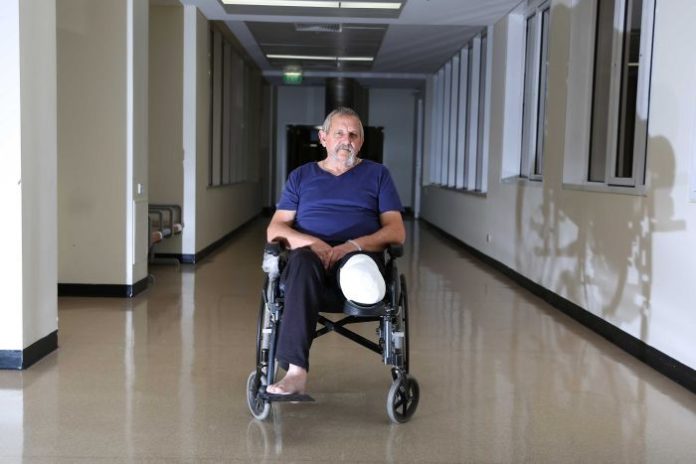What began as a pin-hole sized lesion on the bottom of Alan Tillotson’s foot quickly turned into a nasty infection, leading to the amputation of his leg.
Key points:
- Estimated 4,400 diabetes-related amputations in Australia each year
- 100,000 diagnosed with diabetes in past year alone, says Diabetes Australia CEO
- No formal reporting system in place, but many hospitals report increasing amputations
Like many people with diabetes, the 65-year-old country Victorian truck driver isn’t quite sure how the wound first developed.
It might have been something as minor as a small stone in his thong.
But poor circulation meant the tiny ulcer would not heal, and quickly turned into to a much larger problem.
“I was first diagnosed with diabetes when I went to have my eyes checked,” he said.
“It wasn’t until four years later, two years ago, that all the ulcers started. I’d come into hospital, they’d keep me in for three or four weeks. These ulcers kept on flaring up.
“The last ulcer affected the bone … so it was either get rid of it earlier, or lose the whole leg completely.”
Having already had his toes removed, Mr Tillotson decided to have his leg removed beneath the knee to prevent further spread.
His surgery is one of just an estimated 4,400 diabetes-related amputations occurring in Australia each year.
“It’s a staggering number,” Diabetes Australia CEO Greg Johnson said.
“Today in Australian hospitals, around 12 people will undergo a diabetes-related amputation … it’s something that’s not understood by the public, and we really need to do more, because most of this is preventable.”
According to Diabetes Australia, the problem is on the rise, and is the focus of this year’s National Diabetes Week campaign.
People who have type 1 and type 2 diabetes are at risk.
However, there is no formal national reporting system to monitor the problem.
“There’s many anecdotal reports from hospitals and diabetes clinicians saying they’re seeing more and more of these amputations,” Mr Johnson said.
“And we do know that diabetes is continuing to grow as an epidemic, so in the past year alone we’ve seen another 100,000 Australians diagnosed with diabetes.
“We need to now establish a national initiative; we need to create clear accountability and responsibility in our health system so that primary health networks and health systems are responsible for collecting this information and doing more about prevention.”
With most amputations occurring on lower-limbs, health specialists are urging people with diabetes to carefully manage their condition, as well as maintaining good foot health.
It can be as simple as regular moisturising and daily foot checks for lesions.
‘I just thought it would never happen to me’
Melbourne man Jake Williams knows all too well the problems that come from not staying on top of his diabetes.
The 40-year-old Melbourne father-of-two has had ongoing problems with his feet, which left him without many of his toes in his 20s.
In more recent years it spread into other parts of his left foot.
“This amputation started with a tiny nick — my son knocked my foot with the bathroom door,” he said.
“It’s a disease that can catch on pretty quick and the aftermath it can cause is amazing.
“I’ve had the full ring, I’ve had the kidney transplant, spent time on dialysis, had my eyes operated on and also a toe and foot amputation.”
Mr Williams said he wished he could speak to his younger self.
“I was a young lout, enjoying my mates company with a bit of invincibility I suppose. I’d eat what I wanted to eat, and would skip insulin,” he said.
“If I could take it all back, I’d be checking my sugars regularly, eating that healthy diet, taking my insulin — don’t take anything for granted.
“I just thought it would never happen to me.”




